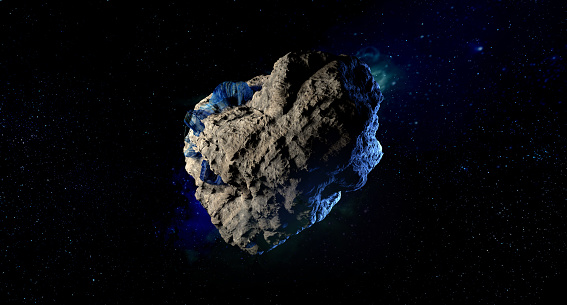NASA's DART mission hits asteroid in first-ever planetary defense test
After 10 months flying in space, NASA’s Double Asteroid Redirection Test (DART) — the world’s first planetary defense technology demonstration — successfully impacted its asteroid target on Monday, the agency’s first attempt to move an asteroid in space.
在太空飞行10个月后,美国宇航局的双小行星重定向测试(DART)——世界上第一个行星防御技术演示——于周一成功撞击了小行星目标,这是该机构首次尝试在太空中移动小行星。
Mission control at the Johns Hopkins Applied Physics Laboratory (APL) in Laurel, Maryland, announced the successful impact at 7:14 p.m. EDT.
位于马里兰州劳雷尔的约翰·霍普金斯应用物理实验室(APL)的任务控制中心于美国东部时间晚上7点14分宣布了这次成功的撞击。
As a part of NASA’s overall planetary defense strategy, DART’s impact with the asteroid Dimorphos demonstrates a viable mitigation technique for protecting the planet from an Earth-bound asteroid or comet, if one were discovered.
作为NASA整体行星防御战略的一部分,DART与小行星Dimorphos的碰撞证明了一种可行的缓解技术,可以保护地球免受地球小行星或彗星的伤害,如果它们被发现的话。
“At its core, DART represents an unprecedented success for planetary defense, but it is also a mission of unity with a real benefit for all humanity,” said NASA Administrator Bill Nelson. “As NASA studies the cosmos and our home planet, we’re also working to protect that home, and this international collaboration turned science fiction into science fact, demonstrating one way to protect Earth.”
美国国家航空航天局局长比尔·纳尔逊说:“从其核心而言,DART代表着行星防御方面前所未有的成功,但它也是一项团结的任务,为全人类带来真正的利益。”“在NASA研究宇宙和我们的家园的同时,我们也在努力保护家园,这种国际合作将科幻小说变成了科学事实,展示了一种保护地球的方法。”
DART targeted the asteroid moonlet Dimorphos, a small body just 530 feet (160 meters) in diameter. It orbits a larger, 2,560-foot (780-meter) asteroid called Didymos. Neither asteroid poses a threat to Earth.
DART的目标是小行星小卫星Dimorphos,一个直径只有530英尺(160米)的小天体。它的轨道是一颗更大的,2560英尺(780米)的小行星,名为Didymos。这两颗小行星都不会对地球构成威胁。
The mission’s one-way trip confirmed NASA can successfully navigate a spacecraft to intentionally collide with an asteroid to deflect it, a technique known as kinetic impact.
该任务的单程行程证实,美国宇航局可以成功操纵航天器有意与小行星相撞,使其偏转,这种技术被称为动能撞击。
The investigation team will now observe Dimorphos using ground-based telescopes to confirm that DART’s impact altered the asteroid’s orbit around Didymos. Researchers expect the impact to shorten Dimorphos’ orbit by about 1%, or roughly 10 minutes; precisely measuring how much the asteroid was deflected is one of the primary purposes of the full-scale test.
调查小组现在将使用地面望远镜观察Dimorphos,以确认DART的撞击改变了Didymos周围的小行星轨道。研究人员预计,撞击会使双形龙的轨道缩短约1%,或约10分钟;精确测量小行星的偏转程度是全尺寸试验的主要目的之一。
“Planetary Defense is a globally unifying effort that affects everyone living on Earth,” said Thomas Zurbuchen, associate administrator for the Science Mission Directorate at NASA Headquarters in Washington. “Now we know we can aim a spacecraft with the precision needed to impact even a small body in space. Just a small change in its speed is all we need to make a significant difference in the path an asteroid travels.”
“行星防御是一项全球统一的努力,影响着地球上的每一个人,”华盛顿NASA总部科学任务理事会副署长托马斯·祖布臣(Thomas Zurbuchen)说。“现在我们知道,我们可以瞄准航天器,其精确度甚至可以撞击太空中的一个小物体。只要它的速度有一个小小的变化,我们就可以对小行星的运行路径产生重大影响。”
The spacecraft’s sole instrument, the Didymos Reconnaissance and Asteroid Camera for Optical navigation (DRACO), together with a sophisticated guidance, navigation and control system that works in tandem with Small-body Maneuvering Autonomous Real Time Navigation (SMART Nav) algorithms, enabled DART to identify and distinguish between the two asteroids, targeting the smaller body.
该航天器的唯一设备,Didymos侦察和小行星光学导航摄像机(DRACO),以及一个复杂的制导、导航和控制系统,该系统与小体机动自主实时导航(SMART Nav)算法协同工作,使DART能够识别和区分两颗小行星,瞄准较小的天体。
These systems guided the 1,260-pound (570-kilogram) box-shaped spacecraft through the final 56,000 miles (90,000 kilometers) of space into Dimorphos, intentionally crashing into it at roughly 14,000 miles (22,530 kilometers) per hour to slightly slow the asteroid’s orbital speed. DRACO’s final images, obtained by the spacecraft seconds before impact, revealed the surface of Dimorphos in close-up detail.
这些系统引导1260磅(570公斤)的盒子形航天器穿过最后的56000英里(90000公里)的空间进入“双形卫”,故意以大约14000英里(22530公里)每小时的速度撞向它,以略微降低这颗小行星的轨道速度。DRACO的最终图像是在撞击前几秒钟由飞船获得的,它以特写细节揭示了二形卫的表面。
Fifteen days before impact, DART’s CubeSat companion Light Italian CubeSat for Imaging of Asteroids (LICIACube), provided by the Italian Space Agency, deployed from the spacecraft to capture images of DART’s impact and of the asteroid’s resulting cloud of ejected matter. In tandem with the images returned by DRACO, LICIACube’s images are intended to provide a view of the collision’s effects to help researchers better characterize the effectiveness of kinetic impact in deflecting an asteroid. Because LICIACube doesn’t carry a large antenna, images will be downlinked to Earth one by one in the coming weeks.
在撞击前15天,DART的同伴意大利轻型小行星成像立方体卫星(LICIACube)由意大利航天局提供,从航天器上部署,捕捉DART撞击和小行星产生的抛射物质云的图像。与DRACO传回的图像相结合,licicacube的图像旨在提供碰撞影响的视图,以帮助研究人员更好地描述动能冲击在使小行星偏转方面的有效性。由于licicacube不携带大型天线,图像将在未来几周内一个接一个地向下连接到地球。
“DART’s success provides a significant addition to the essential toolbox we must have to protect Earth from a devastating impact by an asteroid,” said Lindley Johnson, NASA’s Planetary Defense Officer. “This demonstrates we are no longer powerless to prevent this type of natural disaster. Coupled with enhanced capabilities to accelerate finding the remaining hazardous asteroid population by our next Planetary Defense mission, the Near-Earth Object (NEO) Surveyor, a DART successor could provide what we need to save the day.”
NASA行星防御官员林德利·约翰逊说:“DART的成功为我们必须拥有的保护地球免受小行星毁灭性撞击的基本工具箱提供了重要的补充。”“这表明我们不再无力预防这类自然灾害。再加上我们下一个行星防御任务——近地天体(NEO)测量员——加速发现剩余危险小行星种群的增强能力,DART的继任者可以为我们提供所需的救星。”
With the asteroid pair within 7 million miles (11 million kilometers) of Earth, a global team is using dozens of telescopes stationed around the world and in space to observe the asteroid system. Over the coming weeks, they will characterize the ejecta produced and precisely measure Dimorphos’ orbital change to determine how effectively DART deflected the asteroid. The results will help validate and improve scientific computer models critical to predicting the effectiveness of this technique as a reliable method for asteroid deflection.
由于这对小行星距离地球不到700万英里(1100万公里),一个全球团队正在使用部署在世界各地和太空中的数十架望远镜来观察小行星系统。在接下来的几周里,他们将对产生的喷射物进行表征,并精确测量双形龙的轨道变化,以确定DART如何有效地使这颗小行星偏转。研究结果将有助于验证和改进科学计算机模型,这对预测该技术作为小行星偏转的可靠方法的有效性至关重要。
Read more at ScienceDaily.com
在ScienceDaily.com阅读更多











